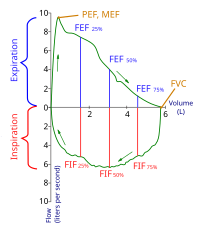
Photo from wikipedia
BackgroundBariatric surgery has proven a successful approach in the treatment of morbid obesity and its concomitant diseases such as diabetes mellitus and arterial hypertension. Aiming for optimal management of this… Click to show full abstract
BackgroundBariatric surgery has proven a successful approach in the treatment of morbid obesity and its concomitant diseases such as diabetes mellitus and arterial hypertension. Aiming for optimal management of this challenging patient cohort, tailored concepts directly guided by individual patient physiology may outperform standardized care. Implying esophageal pressure measurement and electrical impedance tomography—increasingly applied monitoring approaches to individually adjust mechanical ventilation in challenging circumstances like acute respiratory distress syndrome (ARDS) and intraabdominal hypertension—we compared our institutions standard ventilator regimen with an individually adjusted positive end expiratory pressure (PEEP) level aiming for a positive transpulmonary pressure (PL) throughout the respiratory cycle.MethodsAfter obtaining written informed consent, 37 patients scheduled for elective bariatric surgery were studied during mechanical ventilation in reverse Trendelenburg position. Before and after installation of capnoperitoneum, PEEP levels were gradually raised from a standard value of 10 cm H2O until a PL of 0 +/− 1 cm H2O was reached. Changes in ventilation were monitored by electrical impedance tomography (EIT) and arterial blood gases (ABGs) were obtained at the end of surgery and 5 and 60 min after extubation, respectively.ResultsTo achieve the goal of a transpulmonary pressure (PL) of 0 cm H2O at end expiration, PEEP levels of 16.7 cm H2O (95% KI 15.6–18.1) before and 23.8 cm H2O (95% KI 19.6–40.4) during capnoperitoneum were necessary. EIT measurements confirmed an optimal PEEP level between 10 and 15 cm H2O before and 20 and 25 cm H2O during capnoperitoneum, respectively. Intra- and postoperative oxygenation did not change significantly.ConclusionPatients during laparoscopic bariatric surgery require high levels of PEEP to maintain a positive transpulmonary pressure throughout the respiratory cycle. EIT monitoring allows for non-invasive monitoring of increasing PEEP demand during capnoperitoneum. Individually adjusted PEEP levels did not result in improved postoperative oxygenation.
Journal Title: Obesity Surgery
Year Published: 2017
Link to full text (if available)
Share on Social Media: Sign Up to like & get
recommendations!